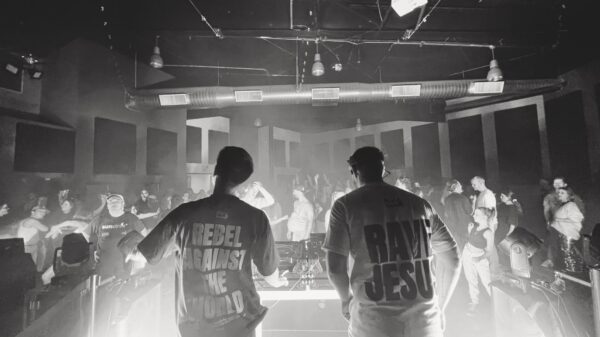byDJBLVD is gearing up to take the Electronic music world by storm, with its recent release ‘Good Love’ this talented Producer and DJ showcases his unique sound and style that is making his name climb higher on the list of Producers to follow closely. Hailing from the vibrant music scene of New York City, byDJBLVD's dynamic blend of Disco, Funk, Soul, and Tech House music has earned him a reputation as a sought-after artist. He has spun for renowned brands like Nike, the Broken Shaker, Hard Rock Casino, House of Yes, and SiriusXM, attracting the attention of many party-goers across the U.S.
This time, we invited this skillful artist to discuss the behind-the-scenes process of one of his latest releases ‘Good Love’.
Hey byDJBLVD! How are you doing?
What's up?! I'm doing well and glad to be here. It's a privilege to sit down and speak with you about two of my recent tracks. Let's get into it!
Can you take us through the initial inspiration or idea that led to the creation of “Good Love”?
I would be happy to take you through the inspiration behind “Good Love.” The inspiration for this track, among my other Latin House tracks, is always unique. I've always felt a solid tie to Latin House or Latin-inspired tracks. They felt the most natural in terms of production. For “Good Love” specifically, I wanted to pay homage to Hispanic Heritage Month and produce a track reminiscent of strong instrumentation, melodies and grooves across various Latin music inter-genres. I derived sounds from Brazilian, Mexican and Peruvian Funk ballads.
Additionally, Hispanic Heritage Month is a time of celebration. It was essential to me to create an energetic, uplifting and joyful song while also blending cultural elements that evoke a feeling of unity and connectedness among listeners. This bridges the gap between cultures.
What were the key elements or instruments you used in the production of this track, and how did you integrate them into the song?
Regarding key elements and instruments for “Good Love,” I started by thinking about the core components I'd need that are prevalent across Latin House historically. These components included but were not limited to, a hearty drum pattern, a potent brass section, a groovy tight bassline, subtle vocals with support from adlibs/chants, vibrant percussion, such as congas, bongos, timbales, etc., and a light synth to carry throughout the song. Of course, you can't forget the signature FX I use across my music: risers, builds, vocal chants, etc. I try to keep my tracks regarding stem count and layering minimal additions. Too many track components can damage your track's integrity rather than aid it. Everything you add to a track should be intentional.
I spent about two weeks structuring the track, beginning with my uniform 16-bar intro. My go-to for arranging a track is introducing or removing a sound every 16 bars, whether strings, percussion, brass, etc. It keeps your listeners engaged and forces you to think of ways to structure your music to add more depth, build upon an upcoming section or close out an existing one. Having said that, this is precisely how I arranged “Good Love,” introducing and removing different elements every 16 bars to maintain the song's high energy. If I can offer any advice to producers, it would be to figure out what aspects you want to lead your tracks and what must be brought down, side-chained, etc. Arranging the track becomes a breeze once you identify what components you want to stand out and others to support.
Could you share some insights into your creative process when it comes to arranging and structuring a track like “Good Love”?
Similar to my previous answer, my creative process when arranging and structuring tracks like “Good Love,” or Latin House as a whole, is derived from the various Latin songs I reference or am influenced by. For “Good Love,” I pulled song arrangement inspiration from ballads across Brazil, Cuba and Mexico. Those genres are what I'm usually listen to daily. I also love listening to House artist Mijangos when creating these songs. He inspires me so much in terms of song structure and how you genuinely build so much energy by integrating the most minor sounds.
Before arranging a song, I'll usually decide how long I want the song to be based on typical track arrangements in the genre. For Latin House, I go for songs around 5:30 to 7:00. It's crucial to understand the historical nature of how songs of a particular genre are structured. It helps you learn how to place every sound in your arsenal properly and, more importantly, make each one count.
Were there any specific challenges or unique moments you encountered while working on this production?
Ironically, there were no challenges I encountered during the production of “Good Love.” However, I vividly remember a unique moment when I perfected my kick for the song. I got up out of my chair and screamed. As I mentioned, the kick is always the most challenging part for me to fall in love within my track, and it was the part I spent weeks on to get right. Honestly, it was really tweaking the compression and decay that was a pain.
Other than that, the consistent yet unique moment I encounter during every production process is finishing the song and giving it a final listen. It never fails to give me goosebumps, and I always sit in awe at how far I've come in the music production game. I have so much more to learn and so much further to go. However, it's always good to acknowledge when you produce a banger!
The track has a captivating groove and rhythm, can you talk about how you crafted the drum patterns and percussion elements in the song?
Crafting the drum pattern and percussion was the hardest part of getting the song to sound good. Beginning with my kicks, I wanted something very hearty. A kick that slapped and left a reverberance on the table as the next one came in. I started with a typical Roland-909 kick. However, the 909 kick drums are a bit weak and too punchy for my liking. Albeit, with some compression tweaking to give it the thickness of a hearty kick, a bit of reverb to give it some “oomph,” light decay and additional filtering, it was golden. The kick was all done through experimentation, like with any song. I re-created my entire drum pattern several times before being happy with it.
As for the rest of the percussion, I always want my tracks to have that UK Garage, 2-step feel. Some elements, such as a light wet clap, snare hits, background bongos and other components, came together naturally. I pulled the sound of these pieces from various Latin tracks I was listening to at the moment. I pulled from a pack dry and mixed them to give it a warm and subtle element to compliment the rest of the melodies and harmonies across the track.
What role did the melodic piano line and horn section play in shaping the overall atmosphere of the track?
The main piano line and horns are arguably the most essential parts of the track itself. Historically, the piano provides the rhythmic foundation for a track, typically known as a pattern called “montuno,” which translates to “comes from the mountain.” You can hear this pattern across the song, from the initial build of the pattern to how it contributes significantly to the danceable feel of the music. Additionally, the piano played a significant role in helping add depth to the song. It brought the track together to evoke a wide range of emotions and direct the emotional ebb and flow, creating tension and release points for each instrument.
Regarding the horns, the ongoing section served the purpose of delivering intensity and power across the track. As soon as you hear the horns come in, it's always with a commanding presence, elevating the song's energy and staying true to the nature of Latin and Latin-inspired tracks. Lastly, the horns helped introduce secondary and tertiary melodies that come in later and add more emotional color to the song, such as the organ component. They really are a tremendous dynamic transition piece.
Were there any new particular production techniques or software/tools you experimented with while working on the song?
For “Good Love,” I definitely got much more comfortable with my MIDI keyboard. As we all know, building upon your skill with an instrument is an ongoing journey. I studied the style and art of playing the “tumbao” and “montuno” rhythms, which are patterns that originated in Afro-Cuban music. While the knowledge wasn't new to me, playing by hand was. Practicing this helped me nail down the feel for my song and bring it to life. Also, I experimented with a new vocal chain in Logic Pro X to help situate my main hooks into the song and make them sound natural. I've mentioned in some other interviews that I'd like to begin incorporating more vocals and lyricism into my tracks, so this was big for me.
“Good Love” has an energetic and vibrant feel, how did you work on maintaining the high energy throughout the track?
Maintaining the high energy of “Good Love” was easy when I thought back to the nature of Latin House songs. Latin House tracks carry much of their traditional high energy through the percussion, drums and other rhythmic elements. The key is bringing it all together in a way that doesn't make it feel like each piece is fighting for a first-place spot. From the kicks to the congas, the complexity yet simplicity in structure helped carry the lively Latin flavor. Secondly, the repetition of the main groove line of the song aided in creating the hypnotic effect that keeps you tapping your feet. Combined with the build-ups and drops across the track through my risers, drum rolls and more, it helped to reintroduce the main rhythm and bring the energy back to an intense high.
Third, I'd say the vocals and basslines played a key role in energy levels. The leading vocal hook, including the chant that sounded like an echo chamber of screams of joy, significantly boosted the track's energy. Much like the repetition mentioned above, the groovy and prominent bassline reinforced the rhythmic patterns and added depth to the overall track sound.
Lastly, the layering of instruments helped create a fuller, richer soundscape and left me with a final product that I knew would keep listeners reeled in from start to finish.
As a producer, how do you approach mixing and mastering to ensure that the final product meets your creative vision and standards?
Approaching mixing and mastering to help bring your track to life and ensure it aligns with your creative isn't a “one size fits all” deal. For me, it took over a year and a half before I felt comfortable mixing down my songs. To this day, mastering is something I still struggle with. What's most important to remember is that perfecting your mixing and mastering is an ongoing journey, and it's all about training your ears and experimentation.
The mix is undoubtedly the most crucial aspect of the two, as a master will help the track shine if the mix is on point. When I started producing, I would send my tracks to multiple engineers with years of experience under their belts. As time passed, I began to listen to some of the artists who inspired me much more methodically, including listening to some of my tracks more intentionally. In doing this, I grew familiar with how I wanted my music to sound, what effects yield various sounds, etc. Ultimately, only you will know what you want the final version of your song to sound like, so studying similar music is crucial to help amplify your skills.
Today, I spent nearly the entirety of my music production process mixing down the track. I'll usually ends with 4 or 5 drafts of the song until it's at a good place that fits both my creative vision and sound quality. I use a relatively straightforward chain in Logic Pro X for mastering. I don't think there's too much science to the master if the mix is good.
Finally, what’s coming up for byDJBLVD?
This is always a great question to end on; I've got several releases slated for the end of the year, mostly UK Garage-focused with some Deep and Latin House tracks mixed in. You can look out for two new tracks dropping on October 27th: “Life Without You,” a Latin-inspired Deep House track, and “The Genius is Me,” a sultry UKG track that's sure to have you dancing from start to finish.
I'm working on some new signings, so that's all I can speak on for now. You'll have to keep up with me for more!
Listen to ‘Good Love’ Now:
https://open.spotify.com/track/5kpUlQ9rdwyvACcGxHvb9f?si=40787f3a66d349ff
byDJBLVD Online











